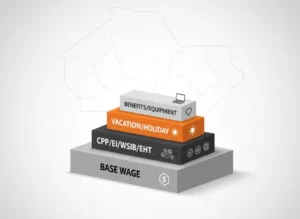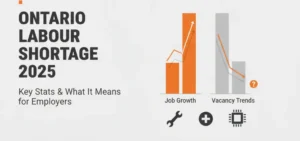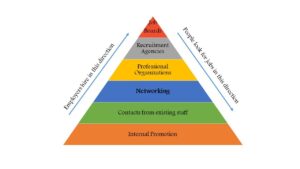If you’re scaling in Ontario, choosing between an Employer of Record (EOR), a temporary help agency, or direct hire can feel like comparing apples, oranges, and… a fruit stand. Each model solves a different problem. The right choice depends on speed, risk tolerance, budget, and how much employer responsibility you’re ready to own. This guide breaks down EOR vs temp agency vs direct hire (Ontario)—what they are, how they work, and how Ontario’s rules affect your decision.
Quick definitions: EOR vs temp agency vs direct hire (Ontario)
- Employer of Record (EOR): A third party becomes the legal employer for your worker(s). You manage the day-to-day; the EOR handles payroll, statutory remittances, benefits administration, and employment contracts in the jurisdiction. It’s common for cross-border or rapid expansion when you don’t want to set up a local entity.
- Temporary Help Agency (THA): A staffing firm hires workers and assigns them to your business on a temporary basis. As of July 1, 2024, Ontario requires THAs (and recruiters) to be licensed to operate. Clients must ensure they only use licensed providers.
- Direct Hire: You recruit and employ talent under your business number. You own the full employee lifecycle—recruitment, onboarding, payroll, compliance, health and safety, and record-keeping. Ontario’s Employment Standards Act (ESA) sets minimum standards including record-keeping obligations.
When each model shines
Choose EOR when:
- You need to compliantly engage talent in a jurisdiction where you don’t have a legal entity (e.g., testing a new Canadian region or international market).
- You want to avoid set-up time for payroll accounts, WSIB, and benefits carriers.
- Roles are specialized or executive-level, but headcount must be added fast.
- You prefer a single monthly invoice covering salary, statutory contributions, and admin fees, with the EOR absorbing employer-of-record liabilities.
Watch-outs: In Canada/Ontario, EOR pricing typically includes a base admin fee or percentage of payroll. You’ll still manage performance and culture. And if you plan to scale a full team here long term, standing up a local entity may be more cost-effective after the pilot phase.
Choose a temp agency when:
- Demand fluctuates and you need flexible capacity—seasonal peaks, project spikes, or coverage for leave.
- Roles are hourly, shift-based, or require fast deployment (warehouse, logistics, manufacturing, events).
- You want to offload sourcing, screening, onboarding, and basic payroll to a partner with a ready talent pool.
- You value try-before-you-hire: many agencies offer temp-to-perm pathways.
Watch-outs: In Ontario, you must use a licensed agency. Clients can face consequences for engaging unlicensed providers. Also, bill rates cover wages plus statutory burdens and the agency’s service margin—great for speed, but per-hour costs can look higher than in-house payroll.
Choose direct hire when:
- The role is core to your business and you’re building long-term capability.
- You want to directly shape employee experience, culture, and retention.
- Your hiring volume justifies investing in a repeatable process, HRIS/ATS, and internal recruiters.
- You’re ready to own compliance—ESA standards, record-keeping, onboarding documentation, and policies.
Watch-outs: Mis-hires are costly. Leadership or management roles can be particularly risky without structured assessments. If you’re scaling quickly, internal teams can get stretched—leading to rushed interviews and bias creeping in.
Want a deeper dive on interview quality? See how bias undermines selection in The Bias of Interviews: Are You Just Hiring a Smile? from our Insights Hub.
Ontario compliance lens: what changes the calculus
1) Licensing for temp agencies and recruiters
Under Ontario’s ESA, temporary help agencies and recruiters must hold a valid licence to operate (in force since July 1, 2024). As a client, due diligence means verifying the licence status before signing. The Ministry maintains a public status page to search applications and licences.
For context and consequences, our explainer Penalties for Non-Compliance: Ontario Recruiter Licence Rules outlines the risks of using unlicensed providers.
2) Employer record-keeping and minimum standards
If you direct hire (or operate a local entity while using an EOR-style arrangement), the ESA requires proper records—hours worked, wage statements, vacation pay, etc. Failing to maintain these can trigger investigations or orders to comply.
3) Psychological health and safety expectations
Beyond minimums, Ontario employers are increasingly expected to foster psychologically safe workplaces—something that’s easier to shape with direct employment or a partner who supports onboarding quality. Explore practical steps in Is Your Workplace Truly Safe? A Guide to Psychological Safety & Health.
Cost comparison: apples-to-apples framing
Every model has visible and invisible costs. Here’s a simple way to compare to choose from EOR vs temp agency vs direct hire (Ontario):
- EOR:
- Visible: Admin fee or % of payroll; benefits premiums; pass-through statutory contributions.
- Less visible: Potential premium for speed; change-order fees; conversion fees if you move the worker to your payroll later.
- Temp agency:
- Visible: Bill rate (wage + statutory burdens + markup); overtime multipliers.
- Less visible: Conversion fees for temp-to-perm; higher per-hour vs. in-house; knowledge loss when assignments end.
- Direct hire:
- Visible: Internal recruiter salaries or external recruiting fees; job boards; background checks; tools (ATS/HRIS).
- Less visible: Vacancy time; ramp-up and training; manager time in interviews; risk of mis-hire.
A practical rule: if a role is strategic and stable, higher up-front investment in direct hire pays off over time. If a role is variable, seasonal, or uncertain, temp staffing or EOR can reduce risk while you validate demand.
Risk profile: who holds the bag?
- Employment liability:
- EOR: The EOR is the legal employer; they carry employment-related obligations. You still lead work direction and must respect health and safety.
- Temp agency: The agency is the employer; as the client, you share responsibilities tied to the worksite (e.g., health and safety), and you must verify licensing.
- Direct hire: You hold all obligations—ESA, OHSA, record-keeping, policies, and terminations.
- Brand and culture:
- EOR/Temp: Workers may feel one step removed from your organisation if onboarding isn’t thoughtful.
- Direct hire: Maximum control and alignment—but also maximum responsibility.
- Speed and scalability:
- EOR/Temp: Fastest to deploy.
- Direct hire: Scales well once your recruiting engine is built.
Decision framework: 7 questions to pick your path
- What’s the time horizon?
< 6 months: lean EOR or temp. 6–24 months: consider EOR or temp-to-perm. 24+ months: build via direct hire. - Where will the work sit?
New jurisdiction or pilot market: EOR. Ontario operations with volume volatility: temp agency. Stable Ontario team: direct. - What’s the compliance appetite?
Low: EOR or licensed THA. Medium–high: direct hire with solid HR operations. - How critical is the role to your IP/culture?
High: direct hire. Medium: EOR now, plan to convert later. Low/variable: temp. - Do you have recruiting capacity?
If not, buy it (temp or an external search partner) while you build capacity. - What’s the true cost of delay?
If every week of vacancy hurts revenue or safety, choose the fastest compliant path. - What’s your tolerance for mis-hire risk?
Leadership roles benefit from structured assessment and trial projects. See The High Cost of a Bad Manager for a practical view on reducing leadership hiring risk.
Ontario scenarios: what good looks like
Scenario A: Seasonal logistics peak (Kitchener/Waterloo corridor)
You need 30 pick-pack associates for 8 weeks. A licensed temp agency is ideal: fast rosters, pre-screened candidates, and straightforward scheduling. If 10 of those workers fit like a glove, plan a temp-to-perm conversion after peak. (Check licence status before onboarding.)
Scenario B: New function, uncertain demand
You’re testing a new service line in Ontario with a specialist you’ve identified. Use an EOR to engage them quickly and compliantly while you validate demand. If the pilot succeeds, transition to direct hire and invest in enablement.
Scenario C: Replacing a frontline supervisor
This is a core role with safety and culture impact. Go direct hire with structured assessments, work simulations, and reference checks to reduce bias and mis-hire risk—then invest in onboarding and psychological safety.
Implementation tips (Ontario-ready)
- Verify licensing (temp agencies/recruiters): Use the Ontario public registry before you sign. Keep a copy in your vendor file.
- Align contracts: For EOR and temp, confirm who owns IP, confidentiality, equipment, scheduling authority, and conversion terms.
- Document records: Even with partners, maintain internal logs of hours, schedules, and pay confirmations for audit readiness.
- Level up onboarding: Align safety training and team norms so EOR/temp workers integrate smoothly with direct employees.
- Plan the endgame: If EOR or temp is your bridge, set a timeline and criteria for converting to direct hire.
How Divino helps Ontario employers choose (and execute) the right model
Whether you land on EOR, temp, or direct hire, success comes down to execution—sourcing quality, onboarding, compliance discipline, and day-to-day workforce support. Divino partners with Ontario employers to:
- Build the right mix of workforce channels for your demand curve
- Implement structured, bias-resistant hiring for permanent roles
- Provide recruitment process outsourcing or scalable temp rosters through licensed partners
- Stand up payroll and HR support that keeps you audit-ready
Explore our services for employers on Hire Confidently. Stay Compliant. Grow Your Workforce.
For regional insights, see how we staff in Kitchener and Waterloo—two hubs where flexible workforce models make a real difference.
One-page comparison: EOR vs Temp Agency vs Direct Hire
| Factor | EOR | Temp Agency | Direct Hire |
|---|---|---|---|
| Speed | Fast (no entity set-up) | Fastest (ready pool) | Slower |
| Best for | New markets, pilots | Seasonal/variable demand | Core, long-term roles |
| Legal employer | EOR provider | Agency | You |
| Compliance burden | Low–Medium | Low–Medium (verify licence) | High (ESA, OHSA, records) |
| Per-unit cost | Medium–High | Medium–High (markup) | Medium–Low (after ramp) |
| Culture control | Medium | Medium | High |
| Convert to perm | Possible, may have fees | Common (conversion fees) | N/A |
Bottom line
- Pick EOR to go fast across borders or while testing Ontario headcount without spinning up a full HR stack.
- Pick a licensed temp agency to handle demand swings and get qualified people on the floor—fast. (Verify licence.)
- Pick direct hire when the role is central to your strategy and you can invest in process, onboarding, and retention.
If you’re still torn, we’ll map your workload, compliance obligations, and budget to a staffing mix that fits your next 12–24 months.
Ready to build the right mix for your 2026 plan? Book a Free Staffing Consultation—we’ll map EOR, temp, and direct options to your demand plan and compliance requirements.













